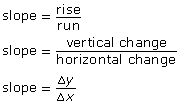Lesson 2
Completion requirements
Created by IMSreader
1. Lesson 2
1.2. Refresher
Module 6: Proportional Reasoning
Refresher
The slope of a line is the measure of the line’s steepness. You can interpret slope in three equivalent ways:

Slope can have positive or negative values, be equal to zero, or be undefined. The slope of a line depends on its orientation. Specifically, this includes the following:
- Lines rising to the right have a positive slope.
- Lines falling to the right have a negative slope.
- Lines parallel to the x-axis (or horizontal) have a slope of 0.
- Lines parallel to the y-axis (or vertical) have a slope that is undefined.
You can calculate the slope of a line by determining the rise and run between any two points on a line. The reason for this is that the slope of a line is constant. The formula for the slope of a line given two points on the line with coordinates (x1, y1) and (x2, y2) is
![]() , where m is the slope
, where m is the slope
Watch the video Investigating Slope to see how you can use points to determine the rise and run of a line.
